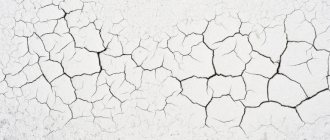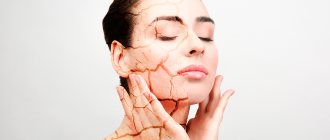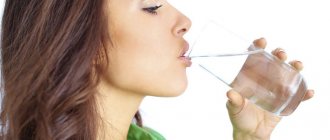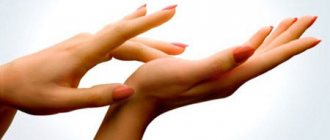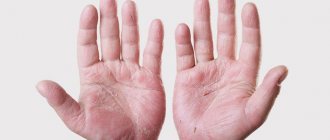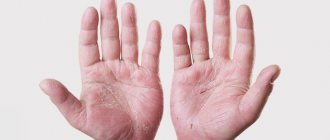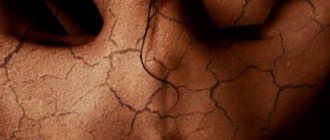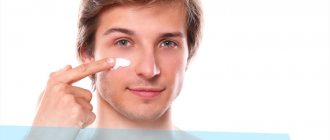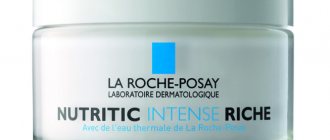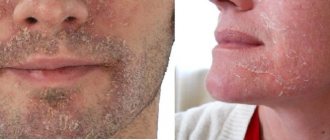Causes of dry skin in babies
According to pediatricians and dermatologists, in the vast majority of cases, dryness on the surface of the baby’s skin is a natural phenomenon that naturally follows from a change in the surrounding microclimate. The newborn's skin has not fully adapted to the air environment after the warm and humid mother's womb.
However, dry and flaky skin in a baby may well be a signal of insufficient care or illness.
Dry baby skin is often a concern for new parents. How to get rid of dryness and flaking of delicate baby skin and prevent this from happening in the future - read this article
External factors causing dryness:
- Cold, windy season.
- Insufficiently humidified air, use of heating devices, air conditioning, lack of wet cleaning of the room.
- Soap or shampoo that is not suitable for a child.
- Careless care of the baby's groin area.
- Use in washing powders not intended for children's clothing.
- Swimming in water above 37 °C - high temperatures cause dry skin in the baby.
- Overheating due to excessive wrapping of the newborn.
- Direct contact with synthetic fabrics that irritate children's skin.
Lack of vitamins is one of the most common causes of dry skin in infants.
Internal disorders of the body, manifested by dryness:
- Lack of vitamins A and PP in the body.
- Incorrect, unbalanced nutrition of the child after birth (or the mother during pregnancy).
- Changes in metabolism, disruption of internal organs.
- Allergy to infant formula, breast milk or other components of the diet. ARVI, colds, elevated body temperature.
- Atopic dermatitis is a skin disease characterized by itching, redness, peeling, and irritation of the skin, most often expressed on the cheeks.
- Ichthyosis is a “family” disease that is inherited (“fish” scales on the skin).
Dry skin as a sign of disease
In some cases, dry dermis may signal the onset of the development of some pathology:
- Atopic dermatitis (more common in children under one year old). Characterized by redness and itching on the face (excluding the nasolabial triangle).
- Ichthyosis. The appearance of scales on the elbows, cheeks, and knees may be a symptom of a genetic disease - ichthyosis, in which keratinization of cells occurs incorrectly;
- Lack of vitamins A and PP;
- Dehydration due to vomiting, diarrhea, increased sweating;
- Diabetes mellitus;
- Thyroid diseases;
- Worm infestation;
- Problems in the gastrointestinal tract.
Atopic dermatitis in an infant
Basic rules for caring for children's skin
Dry skin in a baby needs proper care. Children are fragile creatures, their skin is several times thinner and more sensitive than the skin of an adult.
That is why it is necessary to provide the child with optimal conditions (control the microclimate of the room, food, purchase high-quality non-synthetic clothing, monitor the baby’s hygiene, daily routine).
Monitor the air temperature and humidity level in the children's room - the optimal indicators are 18-20 degrees and 70%, respectively.
The famous pediatrician Komarovsky formulated the following rules for caring for newborns:
- The ideal air temperature in a children's room should be 18-20 °C. Air humidity reaches 50-70%.
To achieve these parameters, an air humidifier or a large aquarium in the baby's room is suitable.
- Daily wet cleaning of the premises without the use of chemicals.
- The absence of things in the interior that accumulate a lot of dust (carpets, large fabric toys).
- Materials for clothing and bedding should be natural, without harmful dyes.
Newborn clothes should be washed only with baby powder, rinsed thoroughly and ironed on both sides.
- When washing, you must use baby powder - this way the child will not have an allergic reaction. After washing, be sure to rinse the items.
- Excessive wrapping of the baby should be avoided.
- Small children do not need a pillow when sleeping. But care must be taken to ensure that the mattress is sufficiently firm (ideally orthopedic).
- Daily bathing after the umbilical cord wound has healed. Until this time, wipe with baby wipes or (with caution) bathing in boiled and filtered water.
- Treat the wound on the navel until healing using hydrogen peroxide, cotton swabs and brilliant green.
- You can only touch your child with clean hands with short nails and no jewelry.
Daily walks in the fresh air are an excellent way to prevent dry skin in babies.
- Daily walks (except when the child suffers from fever). If it is hot outside or, on the contrary, frosty, there is no need to prolong your stay in the air.
- Gymnastics and light massage should also be done every day.
- Feeding is carried out according to a mixed type (a compromise between feeding on demand and according to a strict hourly schedule): the baby should be given food only after his signal, but the intervals between feedings should remain within 3 hours.
Baby creams for dry skin
If a baby has dry skin, he needs two types of cream: moisturizing and soothing.
The difference between them is that a moisturizing cream restores the protective function of the skin after bathing, and a soothing cream is used to prevent diaper rash, irritation, and rashes.
Children's hypoallergenic cream "Umka" combines both properties - it moisturizes and soothes. This cream helps protect delicate skin, reduces inflammation, and has healing properties. It does not contain parabens. Ingredients: panthenol, chamomile extract and olive oil.
French emulsion Mustela Stelatopia moisturizes the skin, restores elasticity, eliminates redness and itching. Designed specifically for dry baby skin, fast-acting.
Johnson's Baby Cream (gentle care) has a softening, moisturizing and nourishing effect. The aroma of the product is pleasant, no fragrances are used. The composition contains extracts of aloe, chamomile, olive, sunflower and soybean oil.
Children's cream "Svoboda" is familiar to everyone in the post-Soviet space. The natural components of the composition and low cost attract parents. The product is effective for diaper rash, prickly heat, helps get rid of burning, itching, refreshes and moisturizes the skin.
How to properly bathe a baby with dry skin
If your baby suffers from dry skin, experts recommend bathing every other day . In the first 30 days of a child's life, water must be boiled and filtered.
Potassium permanganate should not be added to the bath : dermatologists emphasize that it has a drying effect on the skin.
You need to bathe your baby in warm (36-37 degrees) boiled water with the addition of herbs
Herbal decoctions (chamomile, calendula, string) are used as folk antiseptics. They are also recommended for use in bathing children with diaper dermatitis.
When bathing a baby with dry skin, add a tablespoon of flaxseed oil for additional hydration.
After bathing, you should use a moisturizing baby cream.
Consumer Reviews
Karina (wildberries.ru)
“Excellent cream, not greasy, absorbs quickly and results after the first use! We are 2 months old and La-Cri cosmetics suited us perfectly! The foaming shampoo for crusts is also great!”
Vera (wildberries.ru)
“Amazing cream. To tell the truth, I no longer hoped that anything would save my skin. I let it go horribly in the winter; from dry, cracked skin it simply turned into some kind of dermatitis. Not a single advertised Sos cream helped. This cream worked very well. And you only need a little bit, it has a good moisturizing texture. I recommend it to anyone who has problems with very dry skin!”
Sources:
- Reken Martin, Schaller Martin, Sattler Elke, Burgdorf Walter, Atlas of Dermatology, MEDpress-inform, 2020.
- Chapman M. Shane, Habiff Thomas P., Zug Catherine A., Dinoulos James G. H., Campbell James L., Dermatology. Handbook of differential diagnosis, MEDpress-inform, 2014.
- Molochkova Yulia Vladimirovna, Dermatology. Brief reference book, GEOTAR-Media, 2017
Photos of allergies in children
Features of dry scalp care
Pediatricians say: flaky scalp in a baby under one year of age is normal.
However, it is necessary to exclude diseases and factors that negatively affect the scalp:
- you should reduce the use of soap and shampoos to once a week;
- you need to purify water from chlorine using a filter or boil it;
- air humidity should reach 50% and not exceed 70%;
- during the hot season, a hat is required;
- clothing and linen should be made only from natural fabrics.
Reasons and ways to deal with dry skin in a baby
- Causes of dry skin in babies
- Combating dry skin in a newborn
- What to do if your baby has dry skin?
- Dry skin in a baby: what to do?
- How to avoid dry skin?
The soft skin of a child is very thin, but it is easily injured and dries out. Moreover, such dry skin of a baby often causes him a feeling of discomfort and becomes the cause of many diseases. And if the necessary treatment is not started in due time, then various wounds, ulcers, and eczema easily arise. The main thing is to immediately identify the source of the problem and try to remove it. However, if parents cannot do this themselves, then it is best to go for a consultation with the right specialist.
The soft skin of a child is very thin, but it is easily injured and dries out.
When is it time to see a doctor and who to contact?
If, despite all the measures taken, dry skin continues to bother you, damaged areas throughout the body itch, scratching and inflammation appear, irritation intensifies, and the child’s general condition worsens - be sure to consult a doctor. Otherwise, there may be consequences in the form of severe complications.
The pediatrician will rule out serious diseases: atopic dermatitis, psoriasis, ichthyosis, severe forms of allergic reactions. Treatment is prescribed by a pediatric dermatologist.
Repeat the manipulation once a week.
Features of caring for dry skin with allergies
If your baby is diagnosed with an allergy that results in dry skin, take note of the following care rules:
Do not use rough washcloths to bathe your baby.
- Control indoor air humidity.
- Avoid using rough-textured washcloths.
- Bathing water must be boiled.
- After bathing, do not rub the skin, but carefully pat dry with a towel.
- Treat the skin with a hypoallergenic moisturizer (Realba, Mustela Stelatopia).
- Do not use ammonia-containing products during cleaning.
What to do if your baby's skin is dry and cracking
First of all, you need to identify the cause of dryness . It is necessary to analyze whether the child is being properly cared for.
Wet cleaning of the children's room is mandatory when there is a baby in the family
The following key questions will help in this process:
- Is the air sufficiently humidified?
- Is wet cleaning carried out daily?
- How often are heaters or air conditioners used? Is the air temperature comfortable for the baby?
- Has the baby's behavior become restless?
- How long ago have changes in the condition of your skin become noticeable?
- Does the child come into contact with synthetic fabrics (clothing, toys)?
- Has your son or daughter's diet changed recently?
- Have you tested for food allergens?
- Is the baby's hygiene carried out carefully and accurately enough (especially after urination and defecation)?
- Is the water too hot for swimming?
If cracks appear on your baby’s dry skin, be sure to contact your pediatrician - he will choose the right treatment
If there are cracks in the child’s skin, the baby itches, often rubs the skin, there is a danger of infection entering the child’s body. In this case, you should consult your doctor.
Self-administration of potent medications is prohibited. However, you can make your baby feel better by carefully following the rules of care (in accordance with the recommendations of specialists) and using baby cream or oil.
How to remove crusts on forehead
Crusts on the scalp are a sign of seborrheic dermatitis, which can appear in every baby and is not a pathology. It does not require any special treatment, but these scabs need to be removed. They do it like this:
- Half an hour before bathing, the baby's head is lubricated with oil. You can take a baby massage product. It is better to choose sterilized olive or peach oil. Its layer should be thin. A light cap is put on top.
- During water procedures, children's hair is washed with shampoo for newborns. If there are a lot of crusts, you can use special emollients for seborrheic dermatitis.
- After bathing, the baby is thoroughly combed. The comb should be soft, not a comb, but a brush. You can't put pressure on her.
Combing out crusts
You may not be able to comb everything out in one go. This is not scary, as you can continue the next time. Normally, the crusts come off easily after soaking in oil, and the baby’s head does not itch. If peeling does not go away until eight to nine months, then this is a bad sign. Then you need to consult a doctor, he will tell you what to do next.
Baby skin care depending on the season
Pediatricians note that a child’s skin is extremely sensitive to temperature changes - therefore, care for it will be different in winter and summer.
In winter, before going outside, treat your baby's skin with a protective cream.
Winter care
During the cold season, a special protective cream should be applied to the baby’s face and other exposed areas of the skin. Such creams have increased density, which creates a reliable lipid barrier on the skin that prevents chapping.
The product must be used half an hour before going outside.
The condition of a child during a winter walk is monitored by looking at his cheeks: pink color indicates that the baby is comfortable, and pallor or “marbled” white-pink stains indicate that the baby is severely hypothermic. In this case, you should quickly take it to a warm place.
It is strictly forbidden to rub the skin if you have frostbite. You need to wait until the baby warms up and apply D-Panthenol or Bepanten to the newly pink cheeks.
To prevent colds, applying Masque baby aqua baby warming cream to the baby's chest and limbs is effective.
If the walk is completed on time, at home after it they use a regular moisturizer for children.
